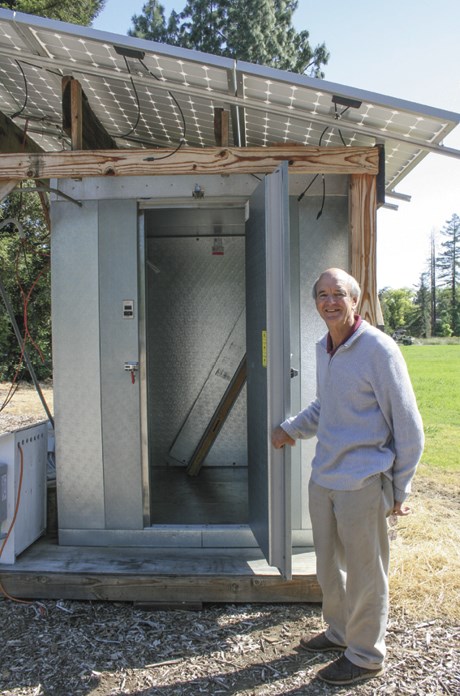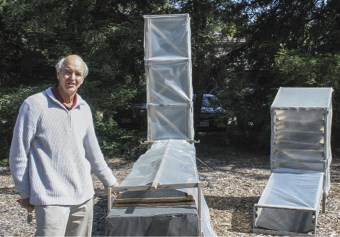UC Researcher Develops Inexpensive Cooler for Farms
This farm-scale cooler can be constructed at a fraction of the cost of conventional units, according to Michael Reid, University of California, Davis, professor emeritus who developed the unit. (photo: Bob Johnson)
Small growers can build their own farm-scale coolers at a fraction of the cost of conventional units, thanks to the invention of a device that adjusts air conditioners into dropping the temperature all the way down to refrigeration levels.
A window or split-unit air conditioner available at most hardware or department stores can be used to create a walk-in cooler that maintains vegetables at about 35 degrees once it is connected to the device, called a CoolBot.
"The advantage is cost and reliability," said Michael Reid, University of California, Davis, professor emeritus in the Department of Plant Sciences. "This is run by a normal air conditioner; the CoolBot unit lets you take it down to lower temperatures. An air conditioner costs around $300, and a CoolBot is about $200. That's much less than commercial refrigeration equipment."
Reid began working to retrofit these cooler units to run on solar energy, which makes it possible to take food saving refrigerator technology to isolated areas that do not have electricity, after first seeing one at a small Northern California vegetable farm.
"We first saw it around 2009 at an organic farm outside Petaluma, where they used straw bales to build the cooler," Reid said. "They're being used by small organic farmers primarily, and by fishermen. More than 27,000 of the CoolBot units have been sold."
A series of controllers make it possible to use a domestic air conditioner, set to cool a room to a comfortable temperature, to refrigerate an area modest enough to be economically practical for a small farmer.
"These air conditioner units are usually set to stop at about 68 degrees," Reid said. "The CoolBot device has a sensor to measure the temperature, a controller to lower the temperature coming from the air conditioner, and a third sensor to turn off the unit when the frost builds up and use the frost to cool."
Reid has worked with other UC researchers to introduce this farm scale technology to farmers in Uganda, Tanzania, Bangladesh, Thailand and Cambodia.
"We have probably put up 15 of these refrigeration units," Reid said. "We are also finding that farmers in remote areas are interested in powering them with solar panels."
There is a demonstration solar-powered CoolBot cooler at the Horticulture Innovation Lab Demonstration Center on the UC Davis campus, and another at the UC Davis Student Farm.
"This area was primarily set up to show people the different projects we're working on," Reid said.
The Horticulture Innovation Lab is involved in a wide range of projects to help make agriculture more sustainable for small farmers in the developing world (http://horticulture.ucdavis.edu/).
The Innovation Lab has a regional center in Thailand and another in Honduras for both research into agricultural technologies and workshops training local farmers in their use.
UC researcher Michael Reid developed this passive solar drier that can be used to dry such crops as tomatoes and leafy vegetables without electricity. (photo: Bob Johnson)
Not far from the cooler is a passive solar drier that maintains efficient drying under variable weather conditions by dragging air through a chimney covered with plastic film.
Farmers in Bangladesh and Kenya already use this low cost, small-scale piece of equipment to dry tomatoes, mangos, herbs and other greens.
"One of these will dry tomatoes in a day or two," said Reid, who is working on the passive solar drier with UC Cooperative Extension specialist in biological and agricultural engineering James Thompson.
A few yards away from the solar drier is an experiment in reducing the time needed to kill weeds and pathogens in the soil through solarization, by insulating the ground at night to prevent the heat from escaping.
In a small plot at the Horticulture Innovation Lab, the ground is covered during the day by clear plastic tarp, and when the sun goes down a layer of the insulation used on water heaters is placed over the tarp.
"You can achieve kill temperatures much quicker," Reid said. "It takes three to five days to kill weed seeds, as opposed to six weeks with regular solarization."
The Horticulture Innovation Lab works on technologies that provide low cost answers on a scale suitable for small farmers to questions commonly faced in agriculture.
The CoolBot was originally invented by New York farmer Ron Khosla, who needed a way to keep his leafy greens and strawberries cold but could not afford the cost of a conventional cooler.
Khosla, a graduate of Cornell University, tinkered until he came up with the series of switches that trick an air conditioner into refrigerating fresh produce, but also stop it before the temperature drops to freezing levels.
At the suggestion of one of his customers, he started a small business, Store It Cold LLC, and began selling the CoolBot to other small farmers around the country.
The company's Internet site includes instructions on how small farmers can use CoolBot to build their own cooler.
From there, researchers saw the device and took the opportunity to retrofit it further to make it suitable for use by small farmers in isolated areas of the developing world.


